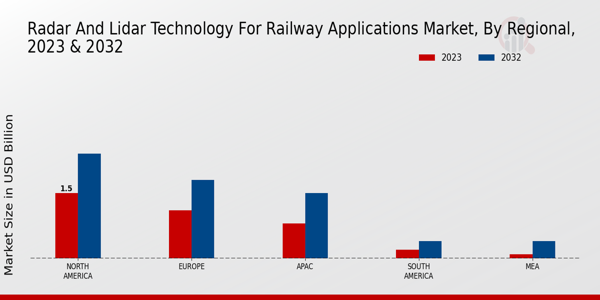Market Growth Projections
The Global Radar Lidar Technology For Railway Applications Market Industry is projected to experience substantial growth over the next decade. With a market value of 4.2 USD Billion in 2024, it is anticipated to reach 8.32 USD Billion by 2035. This growth trajectory suggests a compound annual growth rate of 6.41% from 2025 to 2035. The increasing adoption of radar and lidar technologies in railway applications, driven by safety concerns, government initiatives, and urbanization trends, is expected to fuel this expansion. As the market evolves, stakeholders are likely to explore innovative solutions to meet the demands of modern railway systems.
Technological Advancements
The Global Radar Lidar Technology For Railway Applications Market Industry is experiencing rapid technological advancements that enhance safety and efficiency in railway operations. Innovations in radar and lidar systems allow for improved obstacle detection, real-time monitoring, and automated train control. For instance, advanced lidar sensors can provide high-resolution 3D mapping of railway environments, which is crucial for autonomous train operations. As these technologies evolve, they are expected to contribute significantly to the market's growth, projected to reach 4.2 USD Billion in 2024, reflecting a growing demand for enhanced railway safety and operational efficiency.
Increasing Demand for Safety
Safety remains a paramount concern in the Global Radar Lidar Technology For Railway Applications Market Industry. The integration of radar and lidar technologies is seen as a proactive measure to mitigate accidents and enhance passenger safety. Governments and railway operators are increasingly investing in these technologies to comply with stringent safety regulations. For example, the implementation of lidar systems for collision avoidance has been adopted in several countries, leading to a notable reduction in accidents. This heightened focus on safety is likely to drive the market's growth, with projections indicating a market value of 8.32 USD Billion by 2035.
Environmental Sustainability Goals
The Global Radar Lidar Technology For Railway Applications Market Industry is increasingly aligned with global environmental sustainability goals. As nations strive to reduce carbon emissions and promote greener transportation solutions, railways are positioned as a more sustainable alternative to road transport. The integration of radar and lidar technologies facilitates the optimization of train operations, leading to reduced energy consumption and emissions. For instance, efficient train scheduling and real-time monitoring enabled by these technologies contribute to lower operational costs and environmental impact. This alignment with sustainability objectives is likely to bolster market growth as stakeholders prioritize eco-friendly solutions.
Government Initiatives and Funding
Government initiatives play a crucial role in the Global Radar Lidar Technology For Railway Applications Market Industry. Various countries are allocating funds to modernize their railway infrastructure, which includes the adoption of radar and lidar technologies. For instance, initiatives aimed at enhancing railway safety and efficiency are being supported by federal funding in regions such as Europe and North America. These investments not only facilitate the integration of advanced technologies but also stimulate economic growth within the railway sector. As a result, the market is expected to witness a compound annual growth rate of 6.41% from 2025 to 2035.
Growing Urbanization and Rail Networks
The trend of urbanization is significantly influencing the Global Radar Lidar Technology For Railway Applications Market Industry. As urban populations grow, the demand for efficient and reliable public transportation systems, including rail networks, is increasing. This growth necessitates the implementation of advanced technologies such as radar and lidar for effective monitoring and management of railway operations. Cities are investing in expanding their rail networks, which in turn drives the need for enhanced safety and operational capabilities. Consequently, the market is poised for growth as urban areas seek to modernize their rail systems to accommodate rising passenger volumes.
























Leave a Comment